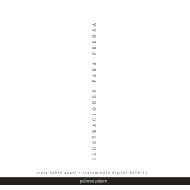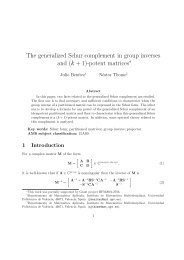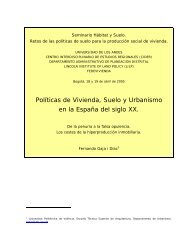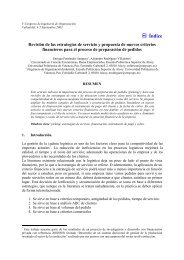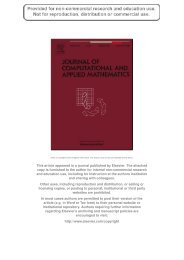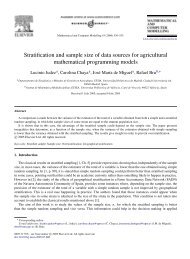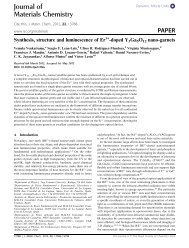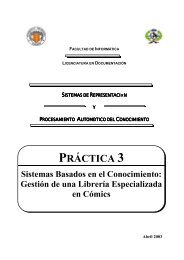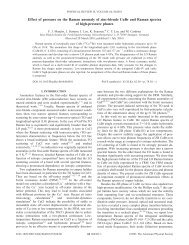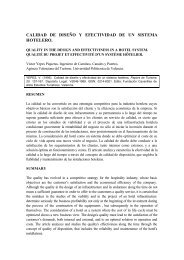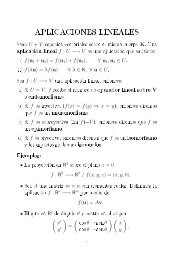Introduction to the resistivity surveying method. The resistivity of ...
Introduction to the resistivity surveying method. The resistivity of ...
Introduction to the resistivity surveying method. The resistivity of ...
Create successful ePaper yourself
Turn your PDF publications into a flip-book with our unique Google optimized e-Paper software.
25<br />
2.7.2 Odarslov Dyke - Sweden<br />
A dolerite dyke surrounded by shales causes a prominent high <strong>resistivity</strong> zone (Dahlin<br />
1996) near <strong>the</strong> middle <strong>of</strong> <strong>the</strong> pseudosection in <strong>the</strong> upper part <strong>of</strong> Figure 17. This is a<br />
particularly difficult data set <strong>to</strong> invert as <strong>the</strong> width <strong>of</strong> <strong>the</strong> high <strong>resistivity</strong> dyke is smaller than<br />
<strong>the</strong> depth <strong>to</strong> <strong>the</strong> lower section <strong>of</strong> <strong>the</strong> dyke. Thus <strong>the</strong> lower part <strong>of</strong> <strong>the</strong> dyke is less well<br />
resolved due <strong>to</strong> <strong>the</strong> reduction <strong>of</strong> <strong>the</strong> resolution <strong>of</strong> <strong>the</strong> <strong>resistivity</strong> <strong>method</strong> with depth. In <strong>the</strong><br />
model section, <strong>the</strong> dyke shows up as a near vertical high <strong>resistivity</strong> body. This data set has<br />
701 datum points and 181 electrodes. While <strong>the</strong> Wenner array is probably not <strong>the</strong> best array <strong>to</strong><br />
map such a vertical structure, <strong>the</strong> dyke is still clearly shown in <strong>the</strong> model section. This survey<br />
was conducted in Sweden by Dr. Torleif Dahlin <strong>of</strong> <strong>the</strong> Department <strong>of</strong> Engineering Geology,<br />
Lund University. In <strong>the</strong> inversion <strong>of</strong> this data set, <strong>the</strong> robust inversion (Claerbout and Muir<br />
1973) option in RES2DINV was used which sharpens <strong>the</strong> boundary between <strong>the</strong> dyke and <strong>the</strong><br />
surrounding country rocks in <strong>the</strong> resulting inversion model. This choice is suitable for this<br />
data set since <strong>the</strong> dyke probably has a sharp boundary with <strong>the</strong> surrounding rocks.<br />
2.7.3 Underground Cave - Texas, U.S.A<br />
This is an interesting example <strong>of</strong> a dipole-dipole survey <strong>to</strong> map caves within a<br />
limes<strong>to</strong>ne bedrock. This survey was carried out <strong>to</strong> map a previously known cave at <strong>the</strong> 4T<br />
Ranch north <strong>of</strong> Austin, Texas. This cave, which is filled with air, causes a prominent high<br />
<strong>resistivity</strong> anomaly near <strong>the</strong> centre <strong>of</strong> <strong>the</strong> pseudosection (Figure 18). <strong>The</strong> data was recorded<br />
with <strong>the</strong> Sting/Swift au<strong>to</strong>matic multielectrode system manufactured by Advanced<br />
Geosciences, Inc. in Austin, Texas and <strong>the</strong> actual recording time was less than 40 minutes. In<br />
<strong>the</strong> course <strong>of</strong> this survey a new cave, subsequently named <strong>the</strong> Sting Cave, was discovered.<br />
This cave causes a high <strong>resistivity</strong> anomaly near <strong>the</strong> bot<strong>to</strong>m left corner <strong>of</strong> <strong>the</strong> pseudosection.<br />
<strong>The</strong> inversion model gives <strong>the</strong> depth <strong>to</strong> <strong>the</strong> <strong>to</strong>p <strong>of</strong> <strong>the</strong> Sting Cave at around 20 feet which<br />
agrees with <strong>the</strong> actual depth directly measured by an underground cave survey.<br />
This is a relatively small data set with 172 data points and 28 electrodes. A complete<br />
inversion <strong>to</strong>ok about 98 seconds (1.6 minutes) on a 90 Mhz Pentium computer, while on a<br />
266 Mhz Pentium II computer it <strong>to</strong>ok only 23 seconds!<br />
Figure 16. (a) <strong>The</strong> apparent <strong>resistivity</strong> pseudosection for <strong>the</strong> Grundfor Line 2 survey with (b)<br />
<strong>the</strong> interpretation model section.<br />
Copyright (1999-2001) M.H.Loke



